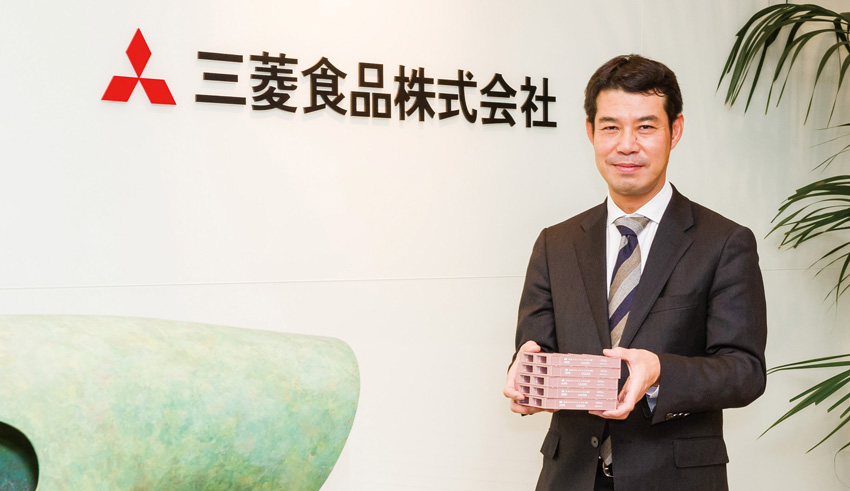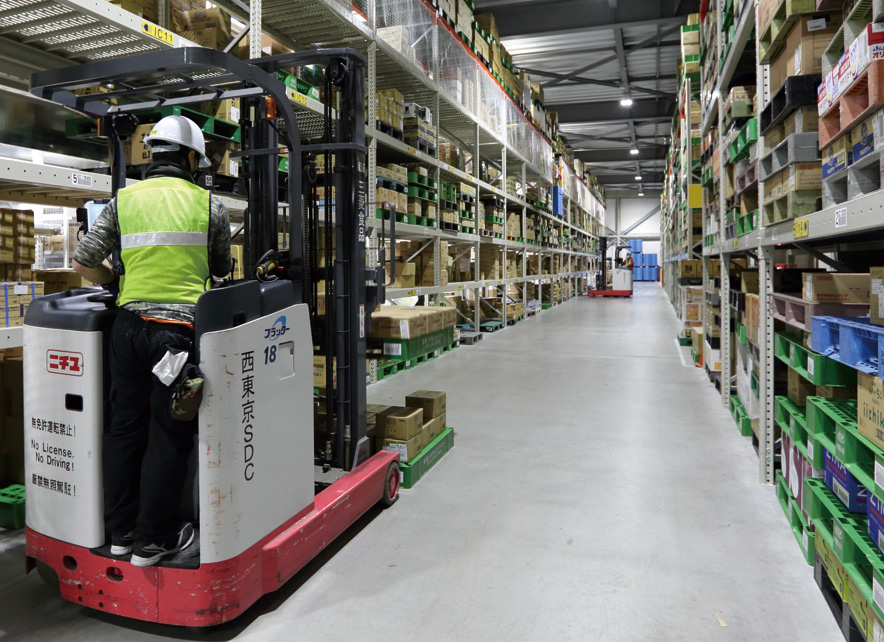Mitsubishi Shokuhin Co., Ltd.
Expansion of pallet circulation system and expectations for IT and new technology
*The information at the time of publication in March 2016 was updated and posted in September 2020.
*Company names and product names mentioned are registered trademarks or trademarks of each company.
Mitsubishi Shokuhin Co., Ltd., is a company that takes on the "core" of the value chain of food and lifestyle, goes beyond the conventional framework of intermediate distribution business, and develops comprehensive product handling systems nationwide. We asked them, a partner company of JPR, which plays a part in the joint collection of rental pallets at distribution bases nationwide, about the features of logistics and the merits of rental pallets.

Mr. Ken Chida, Division COO, Logistics Division, Mitsubishi Shokuhin Co., Ltd.
Advocating as a value chain coordinator and providing optimal solution for logistics
Mitsubishi Shokuhin Co., Ltd. was established in 2011, when the four companies, RYOSHOKU LIMITED, Meidi-ya Corporation, San-Esu Inc., and Food Service Network Co., Ltd., merged. Its main business is domestic and overseas processed foods, low temperature foods, alcoholic beverages, confectionery wholesales, and related logistics and services.
Under the Midi-Term Management Plan 2015, which had been running for four years since 2012, the policy of "balancing food distribution and efficiency and supporting rich food culture and diverse lifestyles" was adopted. With the changes in the environment surrounding food they aimed to be a "value chain coordinator" that builds the optimal distribution for each customer and conveys the richness and enjoyment of food.
The company boasts the top market share as a food wholesaler, has acquired various networks and channels, and is continuing further reforms.
Logistics department that responds to the needs of stockpiling bases that are fully temperature-zone compatible
The company's logistics department provides solutions that combine logistics and information at approximately 300 logistics centers nationwide. Under the Mid-Term Management Plan 2015, they implemented an efficient relocation plan for logistics centers after the integration of the four companies, while establishing a logistics center with functions that respond to growing business formats and new needs. In terms of operation and management, they implemented new environmental policies, developed and introduced a new logistics system, and worked on the mission to create a more efficient and highly utilized logistics center network.
Mr. Ken Chida, General Manager of Logistics Division, Mitsubishi Shokuhin Co., Ltd. explains the characteristics of the company's distribution center as follows.
"One of the ways that meets the needs of supermarket and convenience store customers is a distribution center that supports full temperature zones, for frozen foods, chilled foods, fresh foods, processed foods, etc. We have a single distribution center that can handle the products we need. Now an increasing number of distribution centers are functioning as customers' stockpiling bases and store backyards. In order to respond, we are promoting the concept of a comprehensive distribution center."
Full product lineup support and complete network
Raw materials for processed foods, alcoholic beverages, confectionery, low temperature foods, frozen foods, fresh foods, and side dishes: one of the company's strengths is being able to support the full lineup of these foods. Having a distribution base nationwide, it also has the advantage of network strength. In terms of strengthening as a logistics department, Mr. Chida said, "We are focusing on accumulating know-how in order to acquire the engineering power to establish a processing factory and a delicatessen factory together while establishing a new distribution center." Another target is to reduce labor.
"Because of the labor shortage, we are accelerating our efforts by placing a research unit in the headquarters to save manpower. For example, we are conducting research for robotization for loading and the introduction of unmanned carriers for trolley and pallet transportation."
They are also proceeding to strengthen collaboration with partner companies such as shipping companies and warehousing companies. As they expand their business domain, they are strengthening efforts to win logistics operations from manufacturers and streamline in-store logistics.
Closing the group pallet rental company and switching to JPR rented pallets
Previously, the company had a pallet rental company in the group and used pallets from them and also from JPR. However, they liquidated the group pallet rental company in 2014.
"Our group company had the same idea of promoting standard pallets as JPR, and we used type 11 pallets. When I became the general manager, the company was liquidated and JPR's pallets were used. We decided to close this business because the combined use of pallets was complicated and inefficient, and we thought that we should not be in a position to hinder the overall optimization of distribution. With in-house pallets you need to purchase more during the busy season, and you need a storage area to stock the pallets, and there are also problems with maintenance and disposal. With rented pallets, the number of sheets can change freely during the busy season. There is no need for storage areas, maintenance and disposal. It has sufficient economic rationale. To further improve efficiency with rented pallets, we unified the pallets we use."
As a JPR partner company, we are responsible for the joint collection of pallets
For over 20 years since the time of the merger with RYOSHOKU LIMITED, the company has been playing the role of a joint collection base for rented pallets as a partner company of JPR. Of the company's distribution centers, about 110 distribution centers that deliver many pallets, are JPR rented pallet "collection stores".
Although it varies depending on the season, an average of about 300 companies visits each distribution center – thousands of companies nationwide. Processed foods generally use pallets for distribution, and JPR rented pallets are used for 70% of them. The company accepts about 3 million JPR pallets per year. As the number of companies using JPR pallets is increasing, the number of accepted sheets is inevitably increasing year by year. Mr. Chida says he hopes that "suppliers can make better use of JPR's rented pallets."
"If the delivered products are unified to JPR’s pallets, our side will not have to sort out the empty pallets. JPR's joint collection will be done in a timely manner leaving no stock at our distribution center so there is no stagnation of rented pallets. From the perspective of the supplier side, it is efficient because there is no effort needed to collect empty pallets," says Mr. Chida.
There is great merit in pallet loading and pallet unification
Mr. Chida explains the advantages of palletization and unification of pallets:
"In the case of bulk loading, the driver will unload the cargo, but it will take about 2 hours. Our inspection staff will also be tied up for a long time, so there is no mutual advantage. Compared to that, with pallet loading, you can receive the goods with a forklift, so the work time can be shortened. The unloading time is now about 1/3 to 1/4 of what it used to be. It is effective for speeding up the receiving of goods and shortening the retention time of the delivery truck."
The truck dwell time has become a social issue in many ways, including the driver's working environment, traffic congestion in the surrounding area, and carbon dioxide emissions. Motivation to seriously discuss the shortening of waiting time is increasing.

Although there is a request to give priority to individual loading, pallet loading can shorten the delivery time and waiting time per site, so there is a possibility of delivery to multiple sites per day. However, there are voices expressing the difficulty to deliver products to multiple locations due to the delivery acceptance time, but they are being flexible, such as encouraging consultation with a view to expanding the arrival time window, alongside promoting the utilization of pallets.
Mainly standard size type 11 pallets are used for the processed food industry and type 9 in the liquor industry. On the other hand, for low temperature foods such as refrigerated and frozen foods, there is a problem with unifying the pallet sizes.
"Our company has been using standard sized pallets for a long time, so space efficiency improved in the early stages. As standardization progresses in the field of low temperature foods, the problem of space and unloading will be solved bit-by-bit, and I think it is an issue that we should continue to work on."
Achieve high performance logistics for labor saving and unmanned operation
Mr. Chida described the future outlook of the logistics department as follows:
"The rise in personnel costs and procurement prices is inevitable. Therefore, while expanding our business domain, we would like to promote joint logistics and mutual entry, and to realize high-performance logistics. We need to educate our staff to achieve these measures, as well as promoting cooperation with partner companies. After we achieve stable logistics, we would like to target labor savings and automated logistics."
Finally we asked about any future request to JPR.
"In terms of labor saving and unmanned operations, there are great expectations for expanding the circulation system of rented pallets, and also towards IT and other new technologies. I hope for faster inspections using RF tags, and for inventory I would like to consult with JPR about various initiatives to develop further, such as position tracing. To move further I would like to ask JPR for positive proposals."

